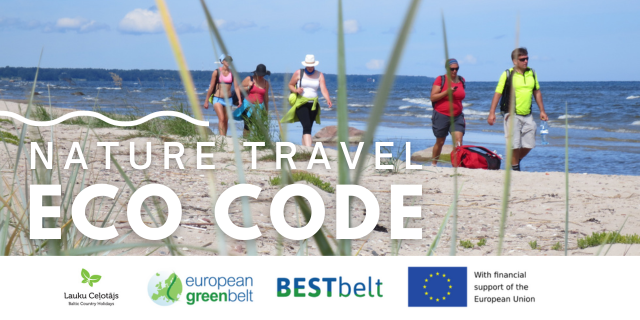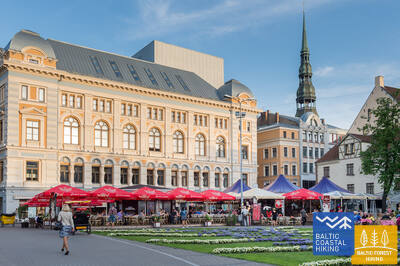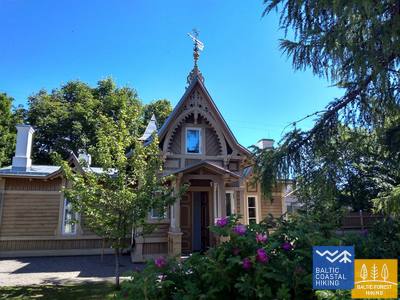Baltic Coastal Hiking trail - Canoeing
 Section 24. Riga City Center - Vecāķi.
Section 24. Riga City Center - Vecāķi.
Riga Old Town – a UNESCO World Heritage site
Initially, the itinerary takes you on a small stroll around Riga City Center, Riga Old Town, leads along the City Canal through Kronvalds Park, via Alberta iela (Art Nouveau buildings) and further on via Miera iela through the Lielie kapi Cemetery, via Kokneses and Ostas prospekts through Mežaparks and then it reaches Jaunmīlgrāvis and crosses Mīlgrāvis . Then it meanders along Vecāķu prospekts up to Ziemeļblāzma and the banks of the Old Daugava River (Vecdaugava) separated by only a couple of kilometers from Vecāķi. After a two-day hike through Riga, the Baltic Coastal Hiking Route leads you out to the beach again.
Riga Canal and Daugava - a popular place for kayaking or canoeing.
 Section 41. Pivarootsi - Virtsu.
Section 41. Pivarootsi - Virtsu.
The Gate to the Estonian Islands
In this section, an ~ 3,7 km stretch of the Baltic Coastal Hiking Route goes along the former Virtsu-Rapla narrow-gauge railway. The most fascinating place in this section is the Puhtulaiu Peninsula: it is an island that has nowadays merged with the continent. It is covered by a broad-leaved forest with interesting plant and mushroom species, giant trees and memorial sites in honour of important people. Ferries go from the Port of Virtsu to Muhu Island which is connected to Saaremaa Island via a dam.
 Section 47. Tuuru - Rohuküla.
Section 47. Tuuru - Rohuküla.
The Second Gate to the Islands of the Moonsund Archipelago
In this section of the Baltic Coastal Hiking Route, the landscape is constantly changing. Small villages interchange with cultivated fields, pastures, individual farmsteads and limestone quarries. The route along the seacoast is limited by wetlands and private properties so the itinerary returns to the sea only at Kiviküla and Pusku villages, where you will see the Väinameri Sea Strait and a lot of islands, and at the Rohuküla port.
 Section 51. Riguldi - Dirhami.
Section 51. Riguldi - Dirhami.
A Place Marked by Meteorites
With the exception of the first 3 km, the itinerary goes along the seashore. It is mainly a sandy beach with beautiful foredunes, grey dunes and sea boulders. The beach may be covered in algae that has been washed ashore and it is occasionally overgrown with dense vegetation. Opposite Rooslepa village and in other places in the sea and on the coast, there are badly weathered stones or the so-called breccias that have melted and weathered as a result of an ancient meteorite explosion. At the destination of the itinerary, you can spend some time in a pub and from its terrace you will have a beautiful view of the sea and the port.
 Section 55. Padise - Paldiski.
Section 55. Padise - Paldiski.
Paldiski: The Former Closed and Top Secret Town
Starting from Padise up to Karilepa, the Baltic Coastal Hiking Route winds through small country roads, while further on to Madise it goes along the side of the road. From the ancient seacoast of the Madise church hill, you will have magnificent views of Paldiski Bay and the Pakri Islands. From Madise to Paldiski, the itinerary continues along the side of the abovementioned road up to the South Harbour and, by going along it, the route reaches the railway station located in the southern part of Paldiski. During Soviet times, Paldiski was a closed town with a military port and a nearby nuclear submarine training base at the Pakri Peninsula that operated using a small nuclear reactor.
From Paldiski, you can go on a sea kayaking trip to the Pakri Islands. For more information, see https://retked.ee/en/trips/sea-kayaking-trips/pakri-islands/
 Section 69. Rusnė Island.
Section 69. Rusnė Island.
Rusnė Island — excellent location for wildlife observation
The Baltic Coastal Hiking Route starts in the village of Rusnė on Rusnė Island. The trail leads through Neringos Street and K. Jukštaičio Street out into Rusnė Village beachside walkway extending along the Pakalnė River — one of the biggest distributaries of the Nemunas Delta. The Baltic Coastal Hiking Route further leads through the small port of Rusnė snaking through the polder dikes of Rusnė over to the village of Pakalnė, providing wonderful views along the way of the colourful architecture of the island and the willow trees overhanging the Pakalnė waters. After the Village of Pakalnė, up until Uostadvaris Lighthouse, the route mostly follows the Rusnė polder dikes, which enclose and interweave the low island (there is a spot on the island that is below sea level) to protect it from flooding. From the lighthouse to the village of Rusnė, the Baltic Coastal Hiking Route goes along the side of a paved road (except in the village of Uostadvaris, where the trail follows the polder dike on the bank of the Atmata River). In the village of Rusnė, the trail follows Kuršmarių Street and Taikos Street back to its starting point. Rusnė Island is located inside the Nemunas Delta Regional Park. The polder dikes are excellent for observing wildlife in the low flatlands — roe deer, elk and birds during spring and autumn migration can be seen here.














